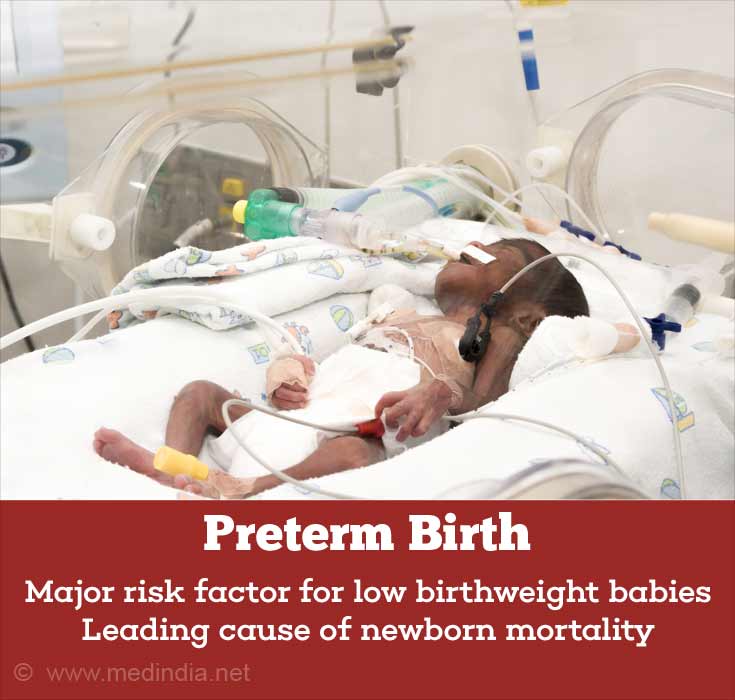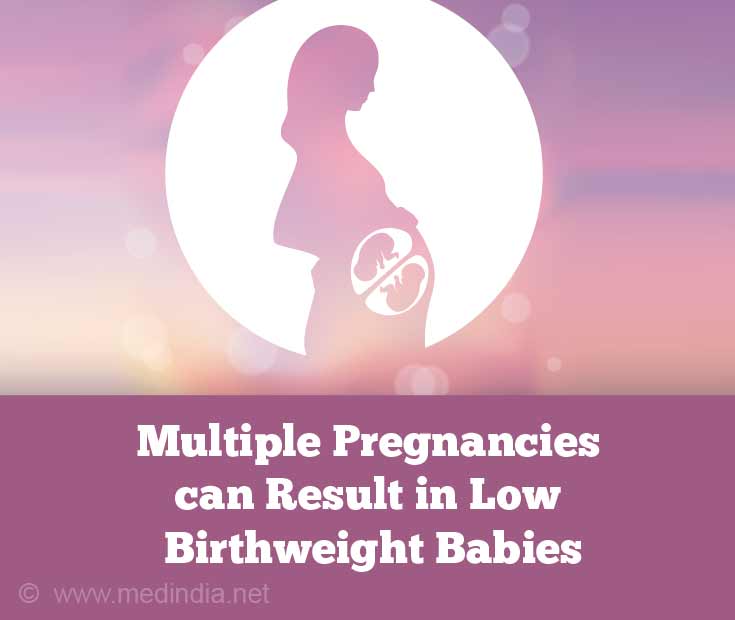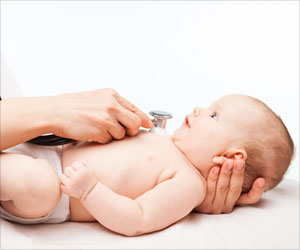- Low Birthweight - (http://www.stanfordchildrens.org/en/topic/default?id=low-birthweight-90-P02382)
- World Health Organization. Care of the preterm and low-birth-weight newborn. Maternal, newborn, child and adolescent health, WHO, Geneva - (http://www.who.int/maternal_child_adolescent/newborns/prematurity/en/)
- American Pregnancy Association. Intrauterine Growth Restriction (IUGR); Small for Gestational Age (SGA) - (http://americanpregnancy.org/pregnancy-complications/intrauterine-growth-restriction/)
- Bharati P, Pal M, Bandyopadhyay M, Bhakta A, Chakraborty S, Bharati P. Prevalence and causes of low birth weight in India. Malays J Nutr. 2011 Dec;17(3): 301-13. PMID: 22655452 - (http://americanpregnancy.org/pregnancy-complications/intrauterine-growth-restriction/)
- Centers for Disease Control and Prevention (CDC). Impact of multiple births on low birthweight--Massachusetts, 1989-1996. MMWR Morb Mortal Wkly Rep. 1999 Apr 16; 48(14): 289-92. PMID: 10227796 - (http://americanpregnancy.org/pregnancy-complications/intrauterine-growth-restriction/)
- Onyiriuka AN. Incidence of delivery of low birthweight infants in twin gestations. Niger J Clin Pract. 2010 Dec; 13(4): 365-70. PMID: 21220847 - (http://americanpregnancy.org/pregnancy-complications/intrauterine-growth-restriction/)
- Ramakrishnan U. Nutrition and low birth weight: from research to practice. Am J Clin Nutr. 2004 Jan; 79(1): 17-21. PMID: 14684392 - (http://americanpregnancy.org/pregnancy-complications/intrauterine-growth-restriction/)
- Ananth CV, Demissie K, Smulian JC, Vintzileos AM. Relationship among placenta previa, fetal growth restriction, and preterm delivery: a population-based study. Obstet Gynecol. 2001 Aug; 98(2): 299-306. PMID: 11506849 - (http://americanpregnancy.org/pregnancy-complications/intrauterine-growth-restriction/)
- Szymonowicz W, Yu VY. Severe pre-eclampsia and infants of very low birth weight. Arch Dis Child. 1987 Jul; 62(7): 712-6. PMCID: PMC1779252 - (http://americanpregnancy.org/pregnancy-complications/intrauterine-growth-restriction/)
- Singh SS, Bordman R, Leyland N. Pregnancy after uterine artery embolization for fibroids. Can Fam Physician. 2007 Feb; 53(2): 293-5. PMCID: PMC1949129 - (http://americanpregnancy.org/pregnancy-complications/intrauterine-growth-restriction/)
- Hua W, Wei Z, Ling F, Song Y, Jian-Rong M, Ping W. Effects of maternal cervical incompetence on morbidity and mortality of preterm neonates with birth weight less than 2000g. Iran J Pediatr. 2014 Dec; 24(6): 759-65. PMCID: PMC4442839 - (http://americanpregnancy.org/pregnancy-complications/intrauterine-growth-restriction/)
Low Birthweight Babies - What Should You Worry About?
The World Health Organization (WHO) defines low birth weight (LBW) babies as those weighing less than 2,500 g at birth, regardless of the gestational age. Babies weighing less than 1,500 g and 1,000 g at birth are considered very low birth weight (VLBW) and extremely low birth weight (ELBW) babies. Babies with low birth weight look much smaller than other babies of normal birth weight. A low birth weight baby’s head may appear to be bigger than the rest of the body.
WHO estimates indicate that the global prevalence of LBW is 15.5%, which accounts for 20 million LBW babies born annually; 96.5% of these births occur in developing countries. Importantly, LBW contributes to 60-80% of all neonatal deaths.
The prevalence of LBW in India is approximately 20%. Males have less frequency of LBW than females. The prevalence is comparatively more in northern India.
Top 10 Alarming Risks of Low Birthweight in Babies
1. Preterm Birth: Preterm births are termed so when babies are born before 37 weeks of pregnancy; being born preterm is a major risk factor for LBW babies and is also indirectly responsible for causing neonatal deaths. Preterm labor, which can expel the baby before attaining 37 weeks of pregnancy can cause preterm births.

2. Intrauterine Growth Restriction (IUGR): This is also known as fetal growth restriction or small for gestational age and refers to the retarded growth of the baby during pregnancy, while it is still in the womb. High blood pressure in the mother, placental abnormalities, infections, smoking, alcohol abuse, prescription drug abuse and drug addiction are some of the factors that can cause IUGR. In IUGR, the baby can weigh less than 90% of normal babies of the same gestational age. Fetal ultrasound can help to detect the condition early.
3. Multiple Pregnancies: Based on data from the Centers for Disease Control and Prevention (CDC), multiple pregnancies are a high-risk factor for the premature birth of babies having LBW. Moreover, twin births can result in LBW babies. The chances of an LBW baby also increases if an LBW baby was born in a previous pregnancy.

4. Poor Nutrition During Pregnancy: Improper diet during pregnancy results in poor nutrition. This can drastically reduce the weight of the baby. Controlled trials have shown that improving the mother’s food intake during pregnancy effectively reduces LBW in babies. Multivitamin-mineral and especially iron-folate supplementation in conjunction with nutritious food during pregnancy is very effective in reducing the chances of LBW babies.

5. Placental Abnormalities: The placenta grows in the womb and supplies the baby with nutrients and oxygen through the umbilical cord. Abnormalities in the placenta can reduce the flow of blood and nutrients, which can limit the baby’s growth. An abnormality called placenta previa, where the placenta is attached to the uterus but blocks the opening of the cervix can lead to a marginally increased risk of LBW babies, but may not be clinically relevant.
6. Infections: Certain infections that attack the baby while still in the womb can cause congenital disabilities. These include cytomegalovirus, chickenpox virus, rubella virus, Toxoplasma and malaria infections. These infections can lead to congenital disabilities and increase the chances of LBW babies.
7. Chronic Diseases: A pregnant mother who is suffering from chronic diseases like high blood pressure (hypertension), type-2 diabetes mellitus, heart disease, respiratory disease, or kidney damage has a much higher chance of giving birth to an LBW baby.
8. Pre-eclampsia: This condition is also called toxemia and is a severe pregnancy complication that is characterized by high blood pressure. A prospective case-control study found that severe pre-eclampsia occurs with LBW babies. The study findings indicate that significantly more babies were delivered before the onset of labor and by cesarean section in the group with pre-eclampsia.

9. Uterine Fibroids: These are non-cancerous growths in the uterus that can develop in women of childbearing age. Studies have found that interventions for treating fibroids such as uterine artery embolization (UAE) can result in LBW babies.
10. Abnormalities of the Cervix: Cervical abnormalities can result in premature delivery as the cervix is under pressure to open up. This condition is technically known as maternal cervical incompetence, which can result in LBW babies.













